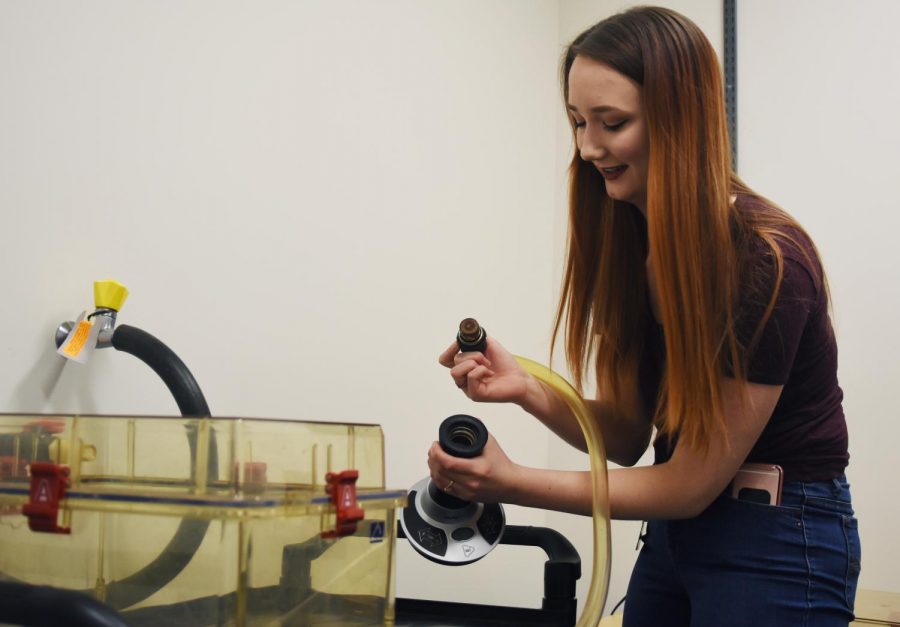Research seeks to explain munchies
Study connects marijuana-induced eating to hormone, could inform treatments
CODY COTTIER | The Daily Evergreen
Joanne Kunze, a senior neuroscience major, demonstrates how she used a vaporizer to intoxicate rats and study how marijuana affects hormones involved in feeding behavior.
April 19, 2018
Joanne Kunze pointed to a tinted plastic box. A hose attached to one end of the container ran to a nearby device labeled “VapirRise 2.0.”
“This is where we get them high,” she said.
The cage is empty now, but the rats Kunze hotboxed over the past year gave some insight into the mechanisms behind eating disorders and the role cannabis can play in treating them.
Everyone knows marijuana causes the munchies, but Kunze, a senior neuroscience major, said the phenomenon isn’t fully understood. She said most studies have focused on how tetrahydrocannabinol, or THC — the main psychoactive ingredient in marijuana — influences appetite. Few have looked at cannabis plant matter, despite it being the drug’s most common form.
So she and other WSU researchers, including Jon Davis, an assistant professor who studies feeding behavior, smoked out some rodents to investigate.
They filled the container with cannabis vapor and fed them what Davis called “standard rodent chow.” They measured how much the rats ate and — predictably — they ate more, and more frequently too.
The researchers pinned down a potential culprit of weed-induced gluttony: ghrelin.
It has long been known as the “hunger hormone,” but Davis said this is the first time anyone has tied ghrelin to cannabis. Once the rats were sufficiently stoned, their ghrelin levels rose and they gorged. After the researchers reduced the amount of the hormone, however, the rats lost their appetites.
Davis said ghrelin could also explain the delay between blazing and binging.
“It’s not like when people smoke marijuana, they immediately go to McDonald’s,” he said. “It’s always a couple hours later.”
This is all interesting conversation for the smoke circle, but Davis said it has the potential to inform treatment for eating disorders and address America’s obesity epidemic, which is estimated to cost about $150 billion in medical spending, according to Centers for Disease Control and Prevention.
Davis said with an understanding of the mechanisms that control ghrelin secretion, they can look into ways of blocking the hormone to prevent people from overeating.
On the flip side, the munchies can be helpful to cancer patients. Davis said many die of anorexia rather than the disease itself. Some synthetic THC treatments are available, but dry cannabis plant matter is more effective at helping patients regain their appetites.
However, without a greater understanding of how this works, Davis said it’s difficult to maximize the benefits for patients.
He said they are working on publishing the study, which he hopes will contribute to the case for giving researchers broader freedom to study cannabis.
They are now only allowed to use plants from a single plot at the University of Mississippi, which has the sole contract with the National Institute on Drug Abuse to grow marijuana. This limits the variety of weed strains they can test.
Kunze said it took them more than a year just to obtain the marijuana, which has less than half the THC concentration of most marijuana on the legal market.
“That whole time it was just frustrating,” she said, “because down the street there was a cannabis dispensary that you could go and buy it from.”
Davis said it’s important to expand the scope of these marijuana feeding studies to test and categorize different strains based on their usefulness to people with feeding pathologies.
But for now, Kunze said, federal regulations remain an obstacle.
“It would be nice to actually have some research, rather than people just screaming that it’s terrible for you or that it’s like eating kale,” Kunze said. “I’ve heard both sides of the argument, and I want to see what it actually is.”









